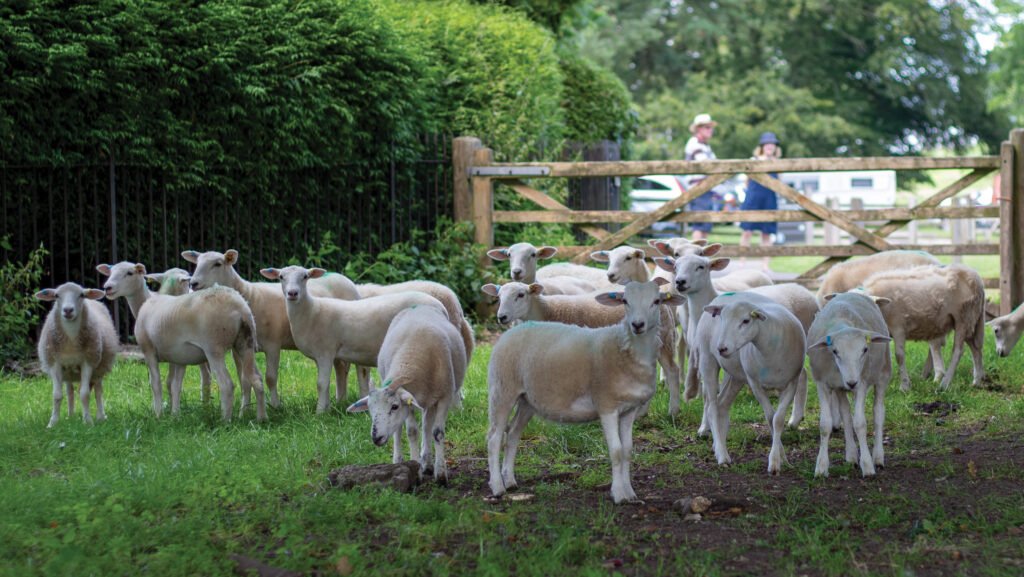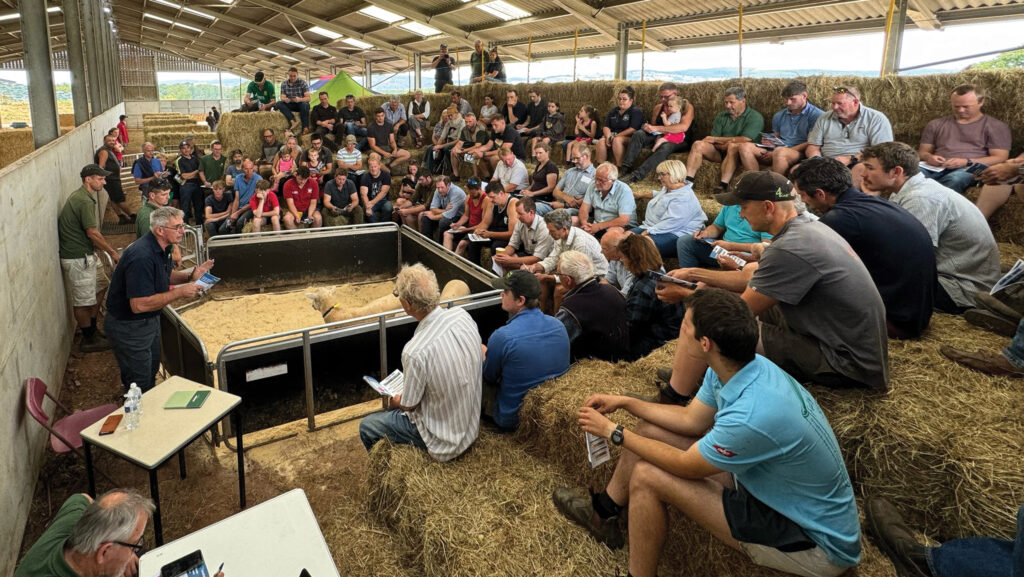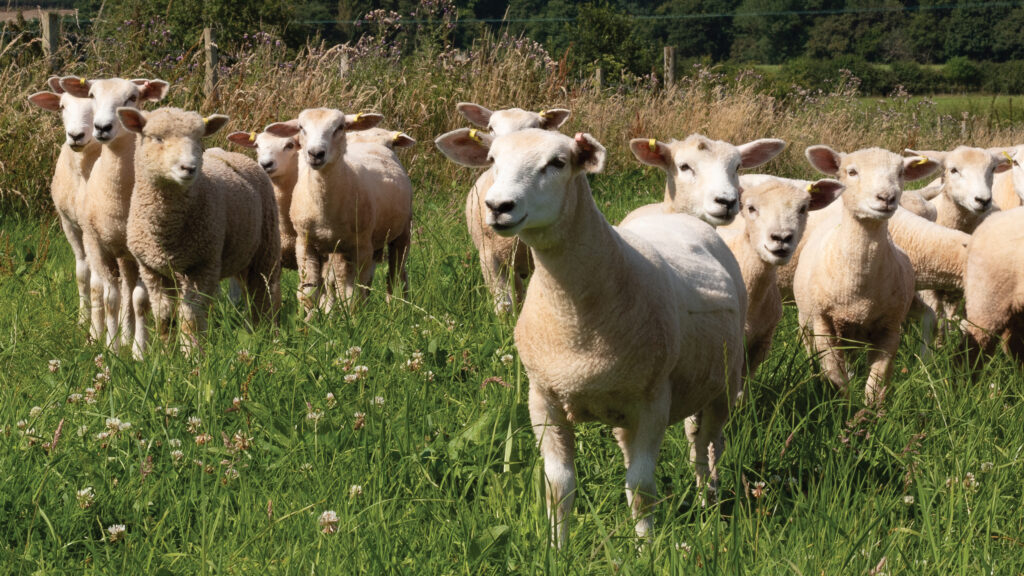Why flock focus is on margins not carcass grades
 Lambs at Cawley Farms © RP Media
Lambs at Cawley Farms © RP Media Cawley Farms is now in its sixth season of outdoor lambing, having switched from a flock of 600 Suffolk cross Welsh Mules lambed indoors.
It has aligned the sheep enterprise with the estate’s block-calving dairy, which is focused on maximising milk from grass.
The flock of 1,000 ewes and 350 ewe lambs lambs outside in April, largely over two weeks, and resides on rented parkland.
William Cawley, who oversees the farming enterprise with his father, Lord John Cawley, says: “The business model isn’t about having big carcasses: it is about producing lamb for less. We are trying to work out how to get the most out of our sheep by doing the least.”
Breeding and performance-recording
The flock comprises Exlana and EasyCare maternal genetics mated to high-index Exlana rams. The whole flock is performance-recorded from birth, and ewe lambs and rams are sold directly for breeding.
The change in policy was a stark contrast for shepherd Mark Hollis, but one he wishes they had made sooner.

A ram sale at Cawley Farms © William Cawley
“I wish we had done it years ago. It’s more enjoyable and requires less labour,” he says.
They use single-sire mating for 25-30 days, with a ewe-to-ram ratio of 70:1, and a 50:1 ratio for ewe lambs.
Growth rates, estimated breeding values (EBVs), ewe efficiency and shedding capability are used to benchmark ewe lambs and rams for customers.
“Our customers are interested in three things: tupping ewe lambs, good EBVs and shedding,” adds William.
Breeding stock is grouped into top, middle and bottom tiers, with prices ranging from £100-125 a head based on hierarchy.
Forage-focused feeding and sales
Sheep rotationally graze on parkland at low stocking rates, with landlord, the National Trust, stipulating they cannot exceed 1-2 livestock units/ha.
They are then wintered on arable cover crops from November until March, when they return to parkland for lambing.
Ram lambs are kept entire and finished on either parkland or clover-rich dairy pasture in the autumn. They are sold to ABP and Euro Quality Lambs.
Carcass weights average 19.5kg deadweight, with 60% achieving a classification of R3L and the remainder 03L.
“Our goal is to produce more R3L lambs, but it is a challenge as we have poor pastures.
“Therefore, we are focusing on testing our sheep to produce an accurate EBV for maternal and worm traits,” says William.
“Our key driver is to achieve a strong margin rather than hit the top grade.”
Because of the strength of the ethnic market, O-grade lambs are only trading at 11p/kg less than R-grade lambs, on average, with prices hitting £115-£130 ahead.
This year, Cawley Farms hosted an on-farm wool-shedding ram sale for the first time (2 August) alongside two other breeders, Low Footprint Lamb UK and Willow Shedders.
The top price was £1,900 for an Ultra White cross Easycare from Low Footprint Lamb, with rams averaging £876 overall.
Farm facts: Cawley Farms, near Leominster
- Farming 647ha, including two rented National Trust properties
- Tupping 1,000 ewes and 350 ewe lambs
- 500-cow autumn-calving dairy, calving for 10 weeks from August
- Flock monitored for maedi visna, borders disease and Johne’s
- Mature ewe size: 60kg
- Number reared (ewes and ewe lambs): 1.61
- Average ewe efficiency at weaning (ewes and ewe lambs): 64%
- Lamb losses from scanning to birth (ewes and ewe lambs): 17% (higher than usual due to poor weather and a toxoplasmosis outbreak)
Challenges of regen approach

Lambs at Risbury Court Farm, Leominster © RP Media
Using home-bred rams for breeding as well as moving towards farming more regeneratively is ensuring Richard Thomas’s flock is profitable.
Richard, who farms near Leominster in Herefordshire alongside his parents, Robert and Diane, refers to his business as a three-legged stool that must balance the environment, economics and a social licence to operate.
Describing his transition to regenerative agriculture, he says: “When I started farming, I was a livestock farmer, but as the system has developed, I’ve realised I need to farm the soil and everything else will fall into place.”
Breeding
His flock of 250 Romney ewes lambs outdoors from March with lambs sold finished to ABP.
“When I started, I was on this everlasting quest for the perfect sheep. We started with Romney Aberfields to increase prolificacy, but now we are seven-eighths Romney. The Romneys have a big rumen for eating lots of grass,” he says.
Richard has focused heavily on culling for poor feet, udders and teeth, but he now says the flock is in a position to lower the replacement rate from 30% to 20-25%.
This should improve gross margins further, he adds.
For the past four years, he has been using his own ram lambs on ewes. These are chosen based on growth rates with good feet, teeth and testicles prerequisites.
They are killed after one year to limit inbreeding.
Richard believes using his own progeny has two benefits: it reduces costs, and epigenetics (how the environment affects genetics before the animal is born) – means the animal born on the farm copes better within the system.
However, he is considering if wool-shedding genetics might be beneficial, and he would need to buy in rams for this transition.
Ewes are mated in November for two cycles and typically scan 175%.
Grassland management
Lambs are weaned before 12 weeks generally, but this year, he weaned at 10 weeks to conserve grass.
Ewes are dried off on permanent pasture, and lambs rotationally graze on multispecies GS4 and SAM3 leys on weekly rounds to reduce workload.
Lambs are achieving growth rates of 200-225g/day, on average.
Rest periods are critical for soil health: “It’s more important where animals are not grazing than where they are,” says Richard.
Lamb losses generally average 15% from scanning to weaning, but Richard concedes they were higher this year because of the bad weather.
Ewes are shorn three times in two years: before lambing, in October and after weaning in July.
He does this largely because he believes it is a good tool for managing body condition and prevents mismothering while lambs are still with ewes.
Shearing costs £1.50 a ewe, and he receives 70p/kg for the fleece.
Regenerative agriculture
Richard concedes it is difficult to farm sheep regeneratively because they require parasitic worming.
But he is trying to limit anthelmintic treatments by co-grazing cattle and sheep, having longer rest periods and monitoring worm burdens by taking faecal egg counts every 3-5 weeks.
For other farmers considering moving to regenerative farming, Richard says it is not that difficult but warns benefits will not be seen overnight.
“I started on the journey 10 years ago. The changes required are not that big: get genetics, management and rotational grazing right, and everything else will be marginal gain.
“If you remove chemicals, it takes a long time, and you won’t grow 8-10t/ha of grass in year one, but you might in year 10 when the soil biology is working properly.”
Farm facts: Risbury Court Farm, Leominster
- Farming 121ha, all grass by next year
- 250 Romney ewes
- Lambs sold deadweight to ABP and killing out at 18-21kg deadweight with grades of U-R3L
- 50 horned pedigree Herefords calving outside over 10 weeks
- Moving from split block to spring
- Stores and heifers sold at 22-26 months to butchers
- 10ha orchards with apples sold to Heineken
